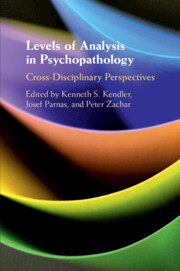Book contents
- Levels of Analysis in Psychopathology
- Advance Praise for Levels of Analysis in Psychopathology
- Levels of Analysis in Psychopathology
- Copyright page
- Contents
- Figures
- Tables
- Contributors
- Preface
- General Introduction
- Part I Neuroscience, Mechanisms, and RDoC
- Section 1
- Section 2
- Section 3
- 7 Introduction
- 8 Tackling Hard Problems: Neuroscience, Treatment, and Anxiety
- 9 Commentary on Daniel S. Pine
- Part II Phenomenology, Biological Psychology, and the Mind–Body Problem
- Part III Taxonomy, Integration, and Multiple Levels of Explanation
- Index
7 - Introduction
from Section 3
Published online by Cambridge University Press: 02 April 2020
- Levels of Analysis in Psychopathology
- Advance Praise for Levels of Analysis in Psychopathology
- Levels of Analysis in Psychopathology
- Copyright page
- Contents
- Figures
- Tables
- Contributors
- Preface
- General Introduction
- Part I Neuroscience, Mechanisms, and RDoC
- Section 1
- Section 2
- Section 3
- 7 Introduction
- 8 Tackling Hard Problems: Neuroscience, Treatment, and Anxiety
- 9 Commentary on Daniel S. Pine
- Part II Phenomenology, Biological Psychology, and the Mind–Body Problem
- Part III Taxonomy, Integration, and Multiple Levels of Explanation
- Index
Summary
Daniel Pine is a child psychiatrist and clinical neuroscientist who has spent the bulk of his research career studying childhood anxiety disorders. His chapter represents such a useful contribution to this volume because it documents the conceptual and empirical work of a working scientist who “lives” the levels problem. Pine’s science is conducted on three major “levels,” the highest of which assesses subjective first-person reports of the clinical symptoms of anxiety disorder in subjects. The lowest level assesses brain function by various imaging methods, especially fMRI. In between these two levels sits neuropsychological assessments – objective measures of specific kinds of mental functioning. Pine is interested in two specific functions: attention and appraisal. The neuropsychological measures function as a bridge between the mental and the systems neuroscience. So, his work sits squarely on the boundary of mind and brain. As Pine summarizes it: “The goal for such work is to explain mental phenomena experienced in the first person at the level of ‘mind’ based on functioning within high-level neural circuitry, at the level of ‘brain.’”
- Type
- Chapter
- Information
- Levels of Analysis in PsychopathologyCross-Disciplinary Perspectives, pp. 89 - 90Publisher: Cambridge University PressPrint publication year: 2020



